by Rishi Gupta, Alireza Biparva, and Pejman Azarsa
Cracks in concrete can become pathways for water and chemicals.1 However, autogenous healing can mitigate these effects. In this article, we describe a test method for evaluating the degree of sealing of cracks, and we use the method to show how it can be applied to evaluate an integral crystalline waterproofing (ICW) chemical admixture for its crack-sealing performance.
Self-sealing in concrete occurs on and between the opposing crack surfaces. Researchers2,3 have shown that sealing depends on various factors and occurs when:
Four major mechanisms for self-sealing are commonly examined4: calcium carbonate formation, continued hydration, sedimentation of particles, and swelling of the cement matrix (Fig. 1(a) through (d)). In addition, numerous companies market agents, supplied as coatings or integral admixtures, that develop crystals within cracks to help achieve watertight concrete structures (Fig. 1(e)) and Fig. 2). Also, researchers have shown that bacteria can be fed a nutrient mixture that enables them to precipitate calcium carbonate within cracks and enhance healing properties.5
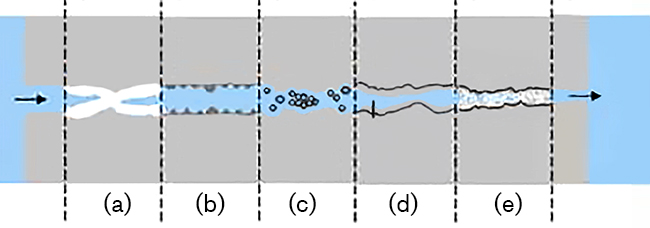
Fig. 1: Self-sealing mechanisms: (a) calcium carbonate formation; (b) continued hydration; (c) sedimentation of particles; (d) swelling of
the cement matrix; and (e) admixture effects

Fig. 2: SEM images of concrete cracks: (a) crack in control (untreated) sample; and (b) crack in sample prepared with crystalline admixture
Our test method characterizes the self-sealing performance of concrete by directly measuring flow rates through cracks.
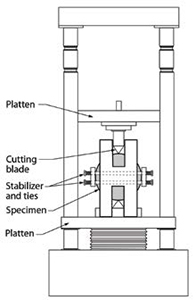
Fig. 3: Schematic of jig for development of consistent cracks in test cylinders
We explored several methods for inducing a crack in a sample. After numerous trials, we developed a custom jig (Fig. 3) 6 that can consistently achieve a target crack width over the diameter and length of a standard 4 x 8 in. (102 x 203 mm) concrete cylinder. Similar to the method used in the conventional split cylinder test,7 a diametral compressive force is applied along the length of the specimen. In contrast to the ASTM method, the force is applied using cutting blades, rather than plywood bearing strips. Also, the jig includes lateral stabilizers to limit the crack width and prevent complete splitting of the sample.
During the development of the test, it was noted that the cracking consistency and repeatability was dependent on a number of factors, with loading rate and sample age having the primary influences. High loading rates typically resulted in cracks larger at the bottom than the top because the load did not transfer throughout the sample. Conversely, a lower load rate transferred through the sample produced a larger crack on the top than the bottom. We found that samples loaded at an optimal loading rate of 20 kN/min (4500 lb/min) would consistently crack uniformly down the center.
We found that the optimum age for splitting samples ranged between 2 and 7 days after casting. Younger samples were found to be too ductile to produce a crack, and so they were crushed by the apparatus. Older samples were found to split suddenly, producing distinct cracks that would separate the sample into two pieces.
To evaluate rate of self-sealing of concrete cracks, precracked samples with comparable crack sizes were identified and fitted into airtight jackets that were fastened tightly around the sample. A PVC cap was fitted and sealed to the top of the sample. Equal-length tubes were attached to the samples and a water reservoir was located above the samples (Fig. 4).
Flow meters were attached to the tubes to monitor the flow of water entering each sample. Water was then allowed to flow through the tubes into the samples, under a water head of 1.5 to 1.6 m (14.7 to 15.7 kPa [2.1 to 2.3 psi]). Water that flowed through each specimen was collected in a container below. The data from the flow meters was stored in a data acquisition system. As the test progressed, the flow rate was verified by periodic measurement of the mass of water collected for each specimen over a given time.
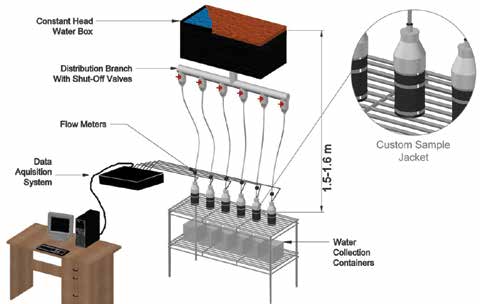
Fig. 4: Schematic of self-sealing test set-up (Note: 1 m = 3.3 ft)
Specimens were produced using mixtures comprising ordinary portland cement (CSA Type GU/ASTM Type I), pea gravel with a maximum aggregate size of 10 mm (0.4 in.), river sand, and potable water. Proportions for the treated samples were identical to the untreated (control) samples, except for an ICW admixture that was added to the mixture at 2% by weight of cementitious materials (Table 1). Multiple specimens were produced using the control mixture (untreated) and using the mixture containing the ICW admixture (treated).
The samples were moist-cured and cracked at an optimum cracking age of 2 days under a loading rate of 20 kN/min. The surface crack on each sample was measured using an optical microscope at 18 equidistant points along the crack (nine along the top face and nine along the bottom face). The measurements were averaged and recorded. The face with the smaller average crack width was considered the “choke”—the area with the most resistance to flow; cylinders were placed on the apparatus with the choke at the bottom. All of the samples experienced a rapid initial flow during the first 2 to 3 days. During this time, specimens were evaluated for comparable flow rate. Outliers were replaced with new cracked samples until the initial flow rate between samples was comparable.
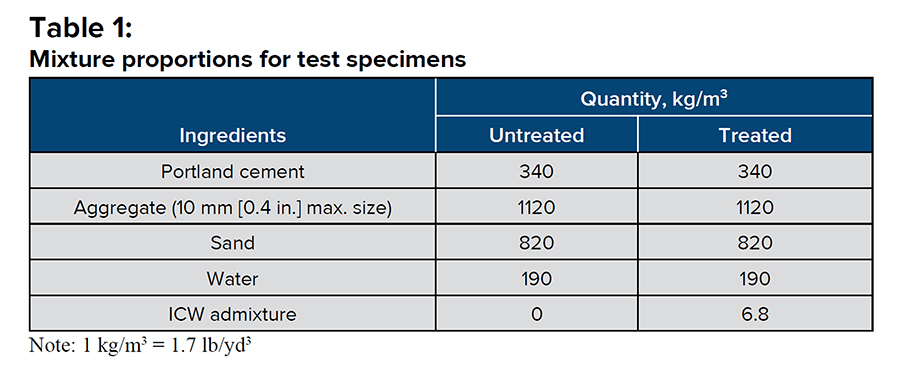
Note: 1 kg/m3 = 1.7 lb/yd3

*Surface crack width determined from average of 18 points along crack surface †Measured by flow meters at start of self-sealing test Note: 1 mm = 0.04 in.; 1 L = 34 fl oz
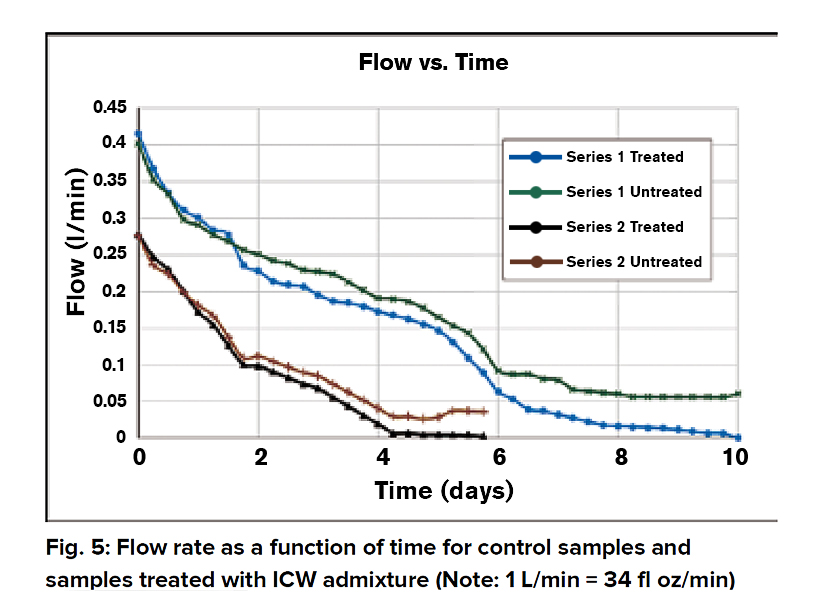
The results for four specimens (two treated and two untreated with the ICW admixture) are shown in Fig. 5 and Table 2. Day 4 (96 hours) was chosen as an appropriate time to compare flow through samples. For all specimens, flow rate decreased with time (Fig. 5). However, the flow rate through the cracks of the treated samples decreased more apidly than the flow rates for the untreated samples. The time required to achieve complete sealing for the two treated specimens shown ranged from only 138 to 240 hours. The time for complete sealing for untreated specimens was not recorded in this study, as the test is typically terminated when the first set of specimens seal. This is done to reduce the amount of water used during testing and to maintain a reasonable test duration.
The presented method shows promise for quantitative evaluation of admixture treatments that promote self-sealing in cracked concrete. The method allows the evaluation of the time required for closure of cracks with various widths, and it is expected that it will allow the evaluation of ICW admixture formulations specifically tailored for unique concrete mixtures and water conditions.
1. Gilbert, R.I., “Shrinkage, Cracking and Deflection—The Serviceability of Concrete Structures,” Electronic Journal of Structural Engineering, V. 1, No.1, 2001, pp. 2-14.
2. Neville, A., “Autogenous Healing—A Concrete Miracle?”, Concrete International,V. 24, No. 11, Nov. 2002, pp. 76-82.
3. Reinhardt, H.-W., and Jooss, M., “Permeability and Self-Healing of Cracked Concrete as a Function of Temperature and Crack Width,” Cement and Concrete Research, V. 33, No. 7, July 2003, pp. 981-985.
4. Ter Heide, N., “Crack Healing in Hydrating Concrete,” MS thesis, Delft University of Technology, Delft, the Netherlands, 2005.
5. Richardson, A.; Coventry, K.; and Pasley, J., “Bacterial Crack Sealing and Surface Finish Application to Concrete,” Proceedings of the Fourth International Conference on Sustainable Construction Materials and Technologies (SCMT4), Aug. 2016, Las Vegas, NV.
6. Yuers, K.; Gupta, R.; and Biparva, A., “Method, Apparatus and System for Testing the Self-Sealing Capabilities of a Concrete Sample,” U.S. Patent Application Publication 2013/0008258 A1, Jan. 10, 2013, 4 pp.
7. ASTM C496/C496M, “Standard Test Method for Splitting Tensile Strength of Cylindrical Concrete Specimens,” ASTM International, West Conshohocken, PA.
Selected for reader interest by the editors.

Rishi Gupta is an Associate Professor and Director of the undergraduate program in the Department of Civil Engineering at the University of Victoria, Victoria, BC, Canada. His areas
of interest include development of sustainable construction technologies, masonry structures, structural health monitoring, and nondestructive testing. He is a member of the ACI International Advisory Committee; and ACI Committees 347, Formwork for Concrete, and 544, Fiber-Reinforced Concrete; and Subcommittee 130-H, Climate Change Impacts on the Sustainability of Concrete. He is also Chair of the International Affairs Committee of the Canadian Society of Civil Engineering (CSCE) and a member of several ASTM C09 subcommittees. Gupta is also a Fellow of Engineers Canada. He received his masters and PhD in civil engineering (materials) from the University of British Columbia (UBC), Vancouver, BC,Canada.

ACI member Alireza Biparva is Technical Manager/Concrete Specialist at Kryton International Inc., Vancouver, BC, Canada. He oversees several leadingedge research projects focusing primarily on concrete permeability studies and development of innovative products and testing methods for concrete waterproofing and construction industries. He is a member of ACI Committees 130, Sustainability of Concrete; 201, Durability of Concrete; and 212, Chemical Admixtures. For the past 5 years, Biparva has given more than 200 presentations on the concrete permeability, waterproofing, durability, and sustainability around the world. In 2004, he received the Best Project Scholarship from the Canadian Cement Association. Biparva received his MS in civil engineering from UBC in 2005.

ACI member Pejman Azarsa has over 8 years of experience both in the industry and academics. His research interests include sustainable infrastructure engineering, corrosion of reinforced concrete structures in marine environment, nondestructive testing of reinforced concrete structures, durability-based design of structures, numerical modeling of deterioration mechanisms of infrastructure, and smart “self-healing” materials. Azarsa is a member of ACI Subcommittee 130-H, Climate Change Impacts on the Sustainability of Concrete. In 2015, he was elected the first President of the University of Victoria Student Chapter – ACI. He received his PhD in civil engineering from the University of Victoria.
SOURCE
Excerpted From Concrete International